- Apply
- Visit
- Request Info
- Give
The Police Social Work Experiment
Written by Michael Rouleau
Published on May 20, 2021
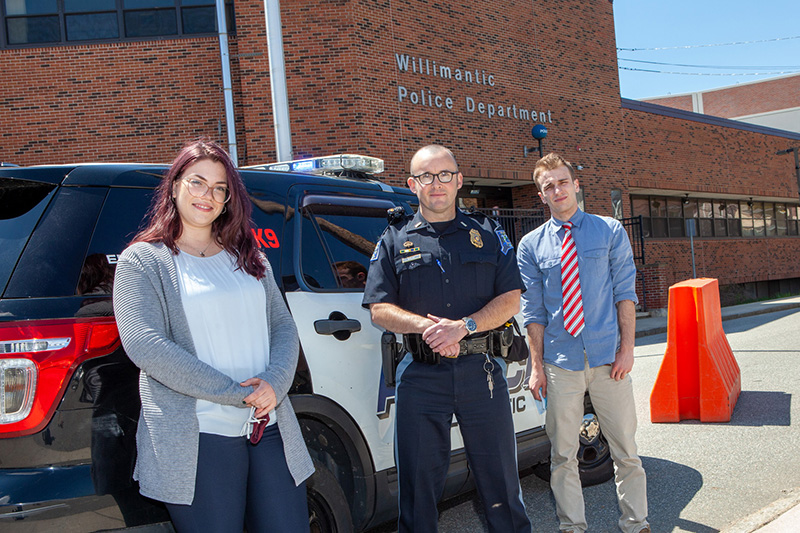
In a time when law enforcement faces heightened scrutiny, the Social Work Program at Eastern Connecticut State University partnered with the Willimantic Police Department on a groundbreaking internship that embedded social work students into the department’s police work. The experimental internship involved two students who served as “bridges to the community” and aided officers in crisis intervention and de-escalation.
The concept of the internship developed in the months following the murder of George Floyd in Minneapolis and after the Connecticut General Assembly passed “An Act Concerning Police Accountability” in July 2020. Section 18 of the act mandates police departments to study the use of social workers in calls for assistance.
During the 2020-21 academic year, senior social work majors Emily Constantino and Ryan Kelly fulfilled 400 hours each in an on-ground internship that engaged them with the community on nonviolent police calls and follow-ups pertaining to mental health, substance abuse, homelessness and other social issues.
“It is common for police departments to receive calls that have nothing to do with crime or criminal activity,” said Constantino. “Embedding social workers into police departments so that they can introduce a higher level of understanding around these social issues is key in ensuring that communities remain safe, supported and united.”
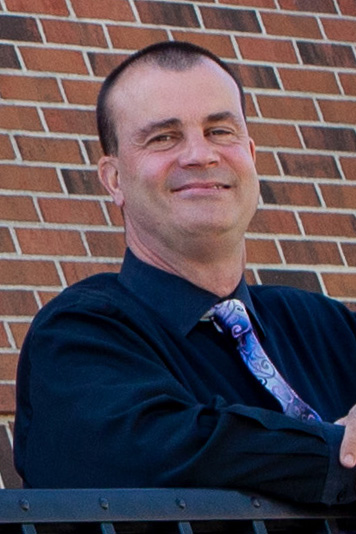
Willimantic Police Chief Paul Hussey explained that many of the department’s calls are by “gravely disabled” individuals — a classification for people who are presently unable to provide for their basic needs due to mental health or substance abuse.
“The system has failed a lot of these people,” said Hussey. “By the time we see them, they’re in crisis . . . we get a week of crisis intervention training, but there are people with degrees in dealing with these issues. It’s in this gravely disabled category — people who can’t care for themselves or need to be committed and evaluated — where I think social work comes in better.”
A crisis situation presents a heightened risk to all involved — perpetrators, officers and bystanders. “What we’re trying to do is head off the crisis stage and get them the services they need before a crisis happens,” said Hussey. “That way we don’t have to use force to get them to go, because a lot of the time when they’re in crisis, they’re at a point of no return and aren’t willing to go.”
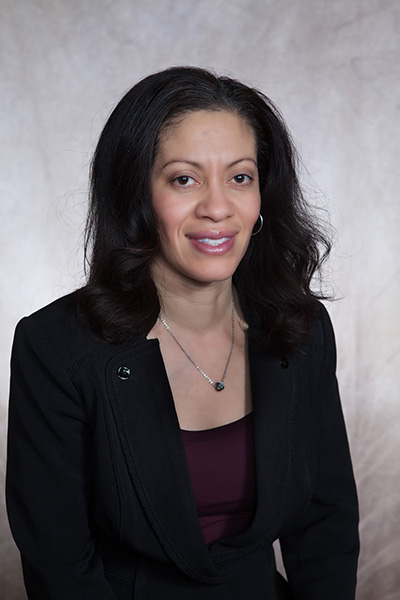
The pilot internship was overseen by Isabel Logan, assistant professor of social work and coordinator of field instruction at Eastern. Prior to joining the faculty, Logan worked for 20 years as a public defender social worker, interacting with the same communities as the police.
“Police social workers have the opportunity to prevent and neutralize cases from escalating to arrest,” said Logan, thereby lowering rates of entry and recidivism into the justice system. As she noted, “The police department is the first point of entry to the court system.”
While not a new concept, police social work has reemerged in the national dialogue surrounding police accountability and the types of incidents that do — and don’t — necessitate an armed officer. But Logan says this partnership is unique in Connecticut as it is the first internship to embed social work students in a municipal police department.
A Part of the Roster
The timing of the internship coincided with the passage of An Act Concerning Police Accountability and its requirement for departments to submit a feasibility report based on their experiments with social work. Willimantic’s verdict? Social work and police work are an effective partnership.
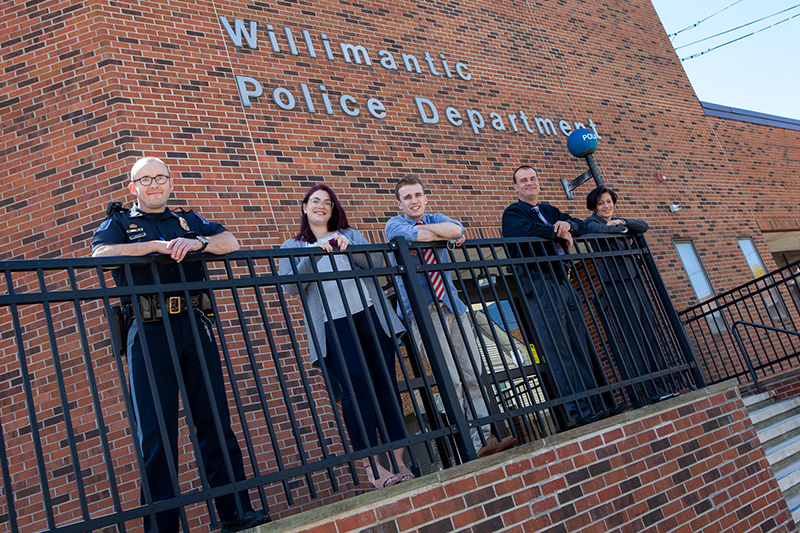
The Eastern interns worked 15 hours a week — day, night and on-call — making follow-up calls and visits, and even accompanying officers on mental health and other nonviolent calls.
Constantino recalls responding with an officer to a report of a drug overdose: “Upon arriving, I met a woman who had just witnessed her close friend overdose in her apartment. This woman was clearly traumatized and was incredibly emotional while watching EMTs try to save her friend’s life. During this situation, I was able to speak with the woman and calm her down while the police officers and EMTs helped her friend. I feel grateful that I was there to provide support for this woman during this call; I can only imagine how terrifying it is to witness something like that happen.”
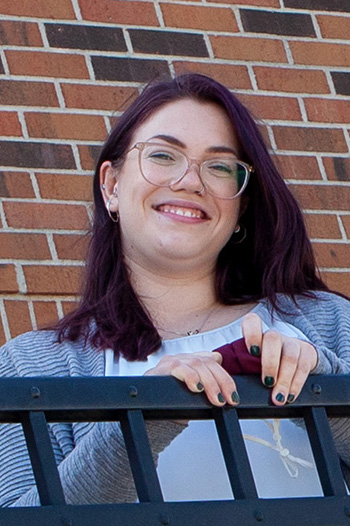
Constantino says social workers use their knowledge of human behavior, diverse populations and social services to create interventions that help clients feel supported during and after times of crisis.
Another situation in which she says social workers are appropriate first responders is for calls regarding suicidal thoughts/behavior — not an uncommon 911 call, according to Constantino. While an officer may respond to the call to secure the scene and transport the individual to the hospital, Constantino said, “A social worker can provide extra knowledge surrounding mental health and crisis intervention and help officers determine whether or not a trip to the hospital is necessary.”
Additionally, Constantino notes that social workers are an asset to domestic violence calls. “A social worker can be there to provide support to victims, in addition to resources that they can use to seek help — domestic violence shelters, support groups, etc. — while officers work to remove the perpetrator from the situation.”
The interns worked closely with Lt. Matthew Solak. “It takes a special type of intern to want to do this, number one, and then to have the characteristics we need on the law enforcement side, so we can trust them and feel confident in their ability to work with us,” said Solak. “It takes somebody with the proper temperament and level of maturity and discipline because they’ve seen stuff and been places that many people don’t get to see and do.”
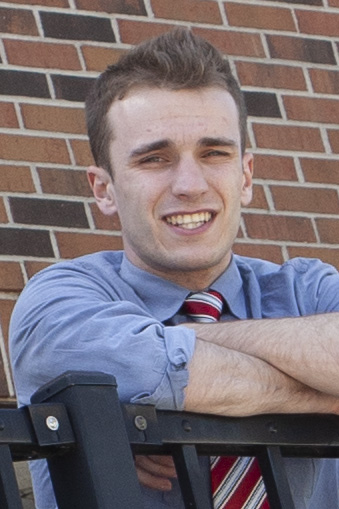
The Willimantic Police Department has worked with interns in the past — mostly in the field of criminal justice — but not in a social work capacity. “Ryan and Emily are like part-time employees; that’s how we see them,” said Solak. “They’re highly autonomous, self-directed, independent... it’s like having two part-time employees on the roster.”
"It's important for social workers and officers to work as a team, as social workers have much more training in mental health issues," said Kelly. "Having them work together will only make the community stronger."
The interns were granted access to the police department’s computer system, which they used to familiarize themselves with client records. “That way, we have an idea of who we’re working with going into the situation; what past experiences might have led to the crisis that they’re experiencing now,” said Constantino.
During follow-up sessions, the interns check in to ensure the client is supported and coping in a healthy manner. Without such follow ups, Chief Hussey says the gap in contact grows until the next crisis. “Unfortunately, that’s just the way the system works right now.”
Solak agreed: “This is work the police would love to do, but we just don’t have enough hours in the day. If we spend all our time following up on mental health calls, we wouldn’t have time to do anything else.”
“One of the great things about our follow-up procedure is that it allows us to show clients that following a crisis, there are still people in the community who care about their well-being and care about how they’re adjusting following this difficult event,” said Constantino. “One of my biggest takeaways is that often people contact the police because they just need to know someone cares about them.”
Stronger Together
“Upon entering this internship, I knew little to nothing about police work,” said Constantino. “I really had no idea how this profession could work together with social work to produce such positive outcomes. I learned very quickly how the two worlds are stronger together than they are apart.”
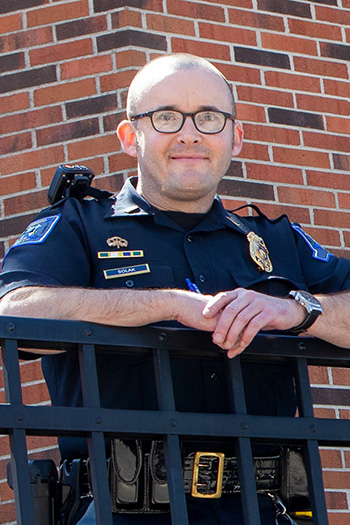
In addition to bringing a different type of sensitivity and training to the police department, Logan says police social workers are a bridge to the community, connecting the department to local residents as well as to the community organizations that deal with the same clientele — recovery centers, homeless shelters, etc.
Further, social workers are a benefit to the department itself, as they can provide a support system to officers who experience trauma and mental health challenges after their time on duty. “In order to effectively serve and protect communities, it is vital that police officers receive the necessary support,” said Constantino, pointing out the prevalence of suicide and depression among the law enforcement profession.
Even with the high-stress situations the students occasionally found themselves in, they reported being well received by community members. Given the political climate surrounding police these days, Logan says the students are ideal participants for this pilot program, as they are “nonthreatening temporary visitors.”
To the critics of the police and those who say the two professions should remain separate, Logan said, “If we don’t work together, how can we fix it?”
Ultimately the Willimantic Police Department would like to hire licensed social workers as full-time staff. In the meantime, the Social Work program and police department hope to continue testing their partnership via this unique internship program.


